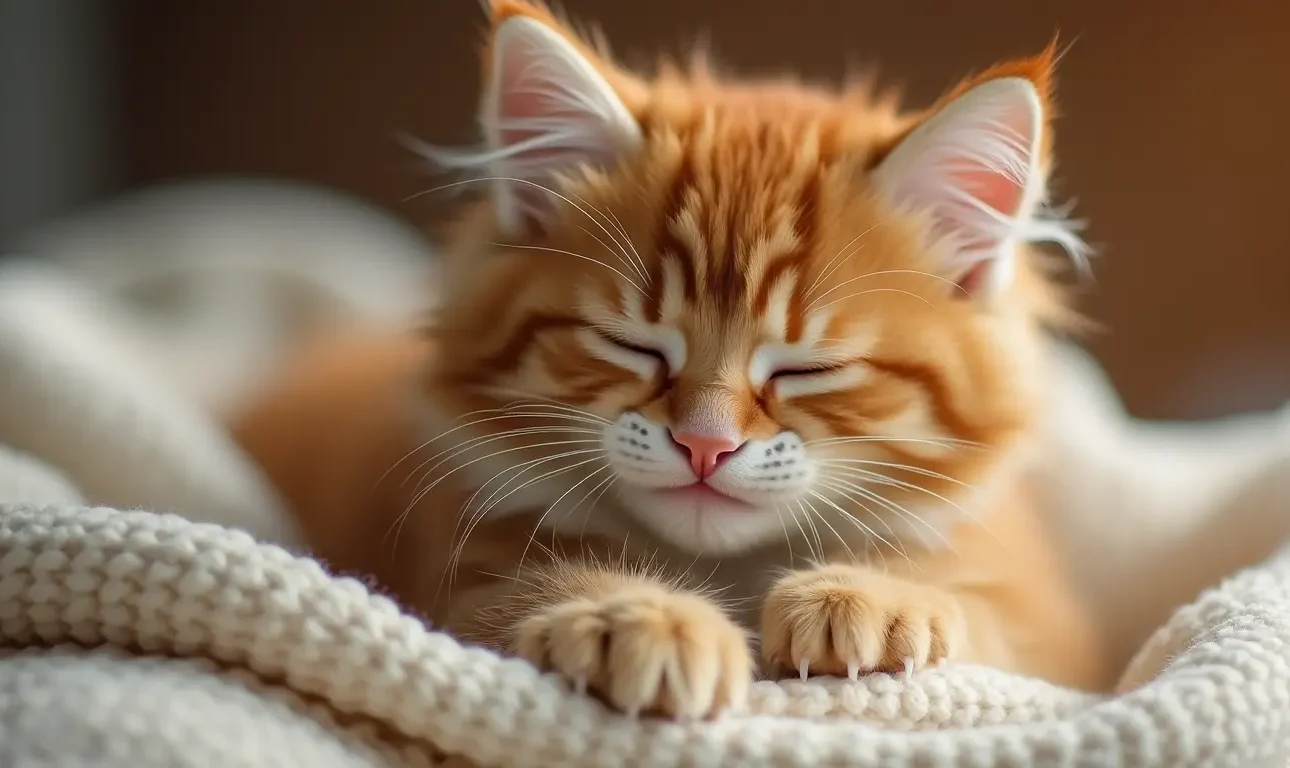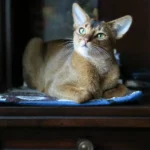Have you ever seen your cat push their paws into a surface while purring? It’s a common sight, but have you ever wondered why they do it? This behavior, known as kneading, is more than just a quirk. It’s a sign of comfort, instinct, and even communication.
By understanding why cats knead, you can better connect with your pet. It shows the complex nature of their lives, from their instincts to their emotional bonds with you. Exploring this behavior can deepen your relationship with your cat, revealing the science behind their kneading.
Table of Contents
Why Do Cats Make Biscuits: Understanding the Basics
Watching your cat make biscuits can be puzzling. Kneading is a natural act for cats, serving several purposes. It helps you understand your cat better and meet their needs.
Cats knead when they’re happy or need comfort. They press their front paws down, often with their back paws moving in rhythm. They like soft spots like cushions or laps to knead on.
Defining the Kneading Behavior
Kneading shows a cat’s emotional state and needs. Knowing when your cat kneads can tell you how they feel. For example, kneading can calm a stressed cat.
When and Where Cats Usually Knead
Cats knead at various times and places. They might knead on your lap, a blanket, or even the floor. Knowing their kneading spots helps you meet their preferences.
Common Materials Cats Choose for Kneading
Cats prefer soft things to knead on, like:
- Cushions and pillows
- Soft blankets and towels
- Laps and legs
Knowing what your cat likes to knead on can make your home cozy for them. It also strengthens your bond.
The Evolutionary Origins of Kneading
Have you ever wondered why your cat kneads? This behavior comes from their wild ancestors. Mother cats used to prepare nests for their kittens by gathering soft materials. Now, your domestic cat kneads, even though they don’t need to make nests anymore.
The kneading cat paws meaning is rooted in their wild past. Kneading is a leftover behavior from their ancestors. It shows your cat’s comfort and security. They knead on soft things like blankets, just like their ancestors did.
Some key points to consider about the evolutionary origins of kneading include:
- Kneading is an instinctual behavior that has been passed down through generations of cats.
- This behavior is closely tied to a cat’s sense of comfort and security.
- Domestic cats exhibit kneading behavior, even though they no longer need to prepare nests in the same way as their wild ancestors.
Understanding the kneading cat paws meaning helps you appreciate your cat more. Whether they knead on your lap or a soft surface, it shows they’re happy and trust their surroundings.
The Biology Behind Your Cat’s Kneading Behavior
When you see your cat kneading and purring, it’s interesting to learn why. Kneading is a complex action that uses muscles in the legs, back, and paws. It’s often seen with purring, a special sound cats make by using their laryngeal muscles.
Research into cat behavior has uncovered the neural paths behind kneading and purring. These paths show that kneading is an instinctual act linked to comfort and security. Your cat might be stimulating scent glands in its paws, marking its territory.
Muscle Mechanics During Kneading
The muscles involved in kneading work together in a complex way. This intricate movement is key to cat kneading and purring. It’s important for your cat’s behavior and happiness.
The Role of Scent Glands
Cats have scent glands in their paws, which they use when kneading. This act helps them mark their territory. It makes them feel comfortable and familiar.
Neural Pathways Involved in Kneading
The brain’s role in kneading and purring is still a mystery. But studies suggest it’s linked to the brain’s reward system. This system releases hormones like dopamine and endorphins, making cats feel relaxed and happy.
Maternal Instincts and Kneading Connections
When you see your cat making feline biscuits, it’s key to know why. This act is linked to their maternal instincts. Kittens knead to get milk and feel safe, which is vital for them. This early bond with their mom shapes their kneading as adults.
Cats knead as a way to calm themselves, much like when they were kittens. They also purr, a habit from their kitten days. Together, kneading and purring bring comfort and a sense of security to your cat.
Some important points about feline biscuit making and maternal instincts are:
- Kittens knead to stimulate milk production and comfort
- Cats continue to knead as adults as a self-soothing action
- Kneading is often accompanied by purring, a trait developed in early kittenhood
Understanding the roots of feline biscuit making helps you appreciate your cat’s behavior more. It also lets you create a more nurturing space for them. This way, your cat can feel safe and comforted while they engage in this natural behavior.
The Emotional Significance of Cat Kneading
Watching your cat knead can reveal a lot about their feelings. This action is more than just a physical act. It shows their emotional state, like feeling safe and loved.
Research links cat kneading and purring closely. When cats knead, they often purr, showing they’re happy and relaxed. This behavior helps them feel calm and secure.
Stress Relief and Comfort
Cats knead to soothe themselves, especially in new places. It’s a way for them to deal with stress and anxiety. Paying attention to these signs is crucial.
Territory Marking Through Kneading
Cats have scent glands in their paws. They knead to mark their territory. This helps them feel secure and in control of their space.
Bond Formation with Owners
When your cat kneads on you, it’s a sign of love and trust. This act strengthens your bond. Understanding the emotional side of cat kneading helps deepen your connection.
When Kneading Becomes Excessive
Watching your cat’s behavior is key. It’s important to know when their kneading is too much. Kneading behavior in cats is natural, but too much can mean they’re stressed or anxious. If your cat kneads a lot or with more force, it might be time to see a vet or change their space to ease stress.
Vets say too much kneading can happen for many reasons. These include:
- Separation anxiety
- Changes in the cat’s environment
- Medical issues, such as arthritis or skin problems
Figuring out why your cat kneads too much is crucial. Knowing why do cats make biscuits helps you fix the problem. This way, your cat can feel safe and happy again.
Being alert to too much kneading helps your cat’s emotional and physical health. You might need to make their space calmer, give them other things to scratch, or get help from a vet or animal behaviorist.
How to Respond to Your Cat’s Biscuit-Making Behavior
As a cat owner, you’ve probably seen your cat kneading. This is a natural behavior for cats. Knowing what it means can help you bond with your pet better. It also helps create a safe space for your cat to be healthy.
To encourage good kneading, give your cat soft places to knead. This could be blankets or mats. Also, protect your furniture from damage by using covers or deterrents. This keeps your home safe and clean.
Encouraging Healthy Kneading
- Provide soft blankets or mats for kneading
- Protect furniture and fabrics with covers or deterrents
- Reinforce positive behavior with praise or treats
By following these tips, you can manage your cat’s kneading. This makes for a happy and healthy relationship. Always be positive and supportive when your cat kneads. This strengthens your bond and makes your cat feel safe and loved.
Conclusion
Cats making “biscuits” or kneading is a natural part of their behavior. It shows their evolutionary roots and emotional side. This behavior can mean comfort, marking territory, or showing love.
Creating kneading spaces and protecting your things can make your cat feel safe and loved. This practice strengthens your bond with your cat. It makes their life better and builds a lifelong trust between you.
So, when your cat kneads, take a moment to appreciate this special behavior. It shows the amazing nature of our feline friends.
FAQ
What is the meaning behind cats kneading or “making biscuits”?
Kneading, or “making biscuits,” is a natural cat behavior. It comes from their kitten days. Back then, they kneaded their mom’s belly to get milk. This comfort action stays with them as adults.
When and where do cats usually knead?
Cats knead on soft things like blankets or pillows. They do this before napping or when they’re feeling relaxed.
What is the evolutionary origin of cat kneading behavior?
Kneading in cats goes back to the wild. Mother cats used to press down on leaves to make a nest for their kittens. This instinct is still in domestic cats, even though they don’t need to make nests anymore.
How does the biology of cats contribute to their kneading behavior?
Kneading uses muscles in the legs, paws, and back. Cats also have scent glands in their paws. They may use these glands to mark their territory while kneading. Plus, kneading often goes with purring, a unique sound cats make.
How is cat kneading behavior connected to maternal instincts?
Kneading is tied to a cat’s maternal instincts. Kittens knead to get milk and comfort from their mom. This behavior stays with them as adults, reminding them of their kitten days.
What is the emotional significance of cat kneading behavior?
Kneading is a way for cats to relax and feel secure. It can also be a sign of affection and trust. Cats knead to bond with their owners.
When can cat kneading become excessive, and what should owners do?
Excessive kneading might mean a cat is stressed or anxious. Owners should notice this and talk to a vet or animal behaviorist. They can help find the cause and fix it.
How can owners encourage and manage their cat’s kneading behavior?
Give your cat soft places to knead, like blankets. Protect your furniture from kneading damage. Use covers or deterrents. Positive reinforcement, like praise or treats, helps manage kneading and strengthens your bond.






